Analysis of G-Train Information System for Queensland Rail
VerifiedAdded on 2022/11/28
|12
|4962
|137
Report
AI Summary
This report analyzes the G-Train's current manual ticketing and checkout system, identifying its challenges and proposing a new information system to improve efficiency and customer experience. The report begins with an executive summary and introduction, outlining the objectives and structure. It then provides background information on the G-Train, including its strategy and the application of Mintzberg's model and Porter's Value Chain. The analysis delves into Porter's Five Forces model to assess the competitive landscape. The core of the report recommends an automated information system with biometric entry devices to address issues like overcrowding and ticket validation. This system aims to streamline the boarding process and enhance the overall user experience. The report concludes with a detailed discussion of the existing human activity system and the proposed improvements.
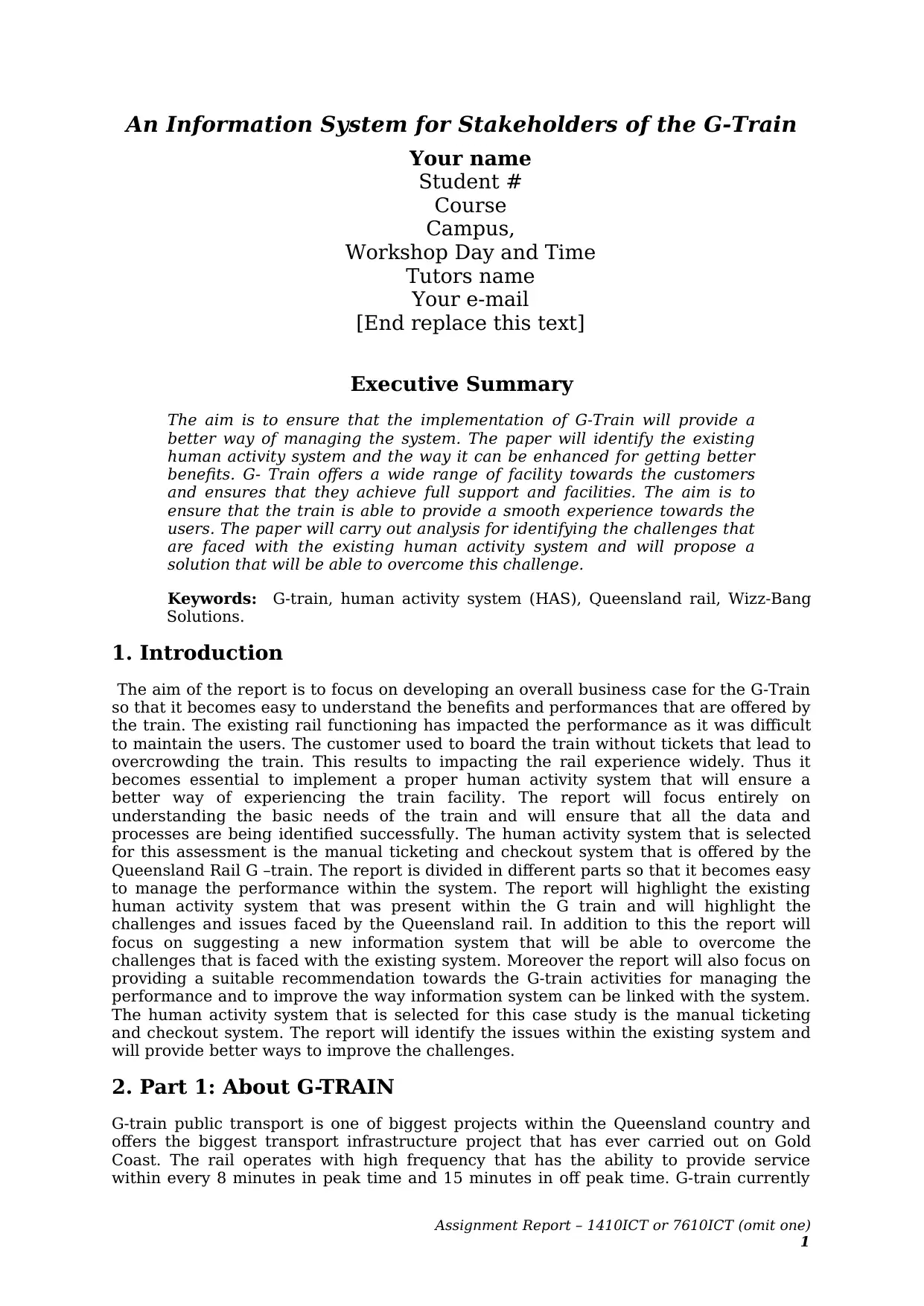
An Information System for Stakeholders of the G-Train
Your name
Student #
Course
Campus,
Workshop Day and Time
Tutors name
Your e-mail
[End replace this text]
Executive Summary
The aim is to ensure that the implementation of G-Train will provide a
better way of managing the system. The paper will identify the existing
human activity system and the way it can be enhanced for getting better
benefits. G- Train offers a wide range of facility towards the customers
and ensures that they achieve full support and facilities. The aim is to
ensure that the train is able to provide a smooth experience towards the
users. The paper will carry out analysis for identifying the challenges that
are faced with the existing human activity system and will propose a
solution that will be able to overcome this challenge.
Keywords: G-train, human activity system (HAS), Queensland rail, Wizz-Bang
Solutions.
1. Introduction
The aim of the report is to focus on developing an overall business case for the G-Train
so that it becomes easy to understand the benefits and performances that are offered by
the train. The existing rail functioning has impacted the performance as it was difficult
to maintain the users. The customer used to board the train without tickets that lead to
overcrowding the train. This results to impacting the rail experience widely. Thus it
becomes essential to implement a proper human activity system that will ensure a
better way of experiencing the train facility. The report will focus entirely on
understanding the basic needs of the train and will ensure that all the data and
processes are being identified successfully. The human activity system that is selected
for this assessment is the manual ticketing and checkout system that is offered by the
Queensland Rail G –train. The report is divided in different parts so that it becomes easy
to manage the performance within the system. The report will highlight the existing
human activity system that was present within the G train and will highlight the
challenges and issues faced by the Queensland rail. In addition to this the report will
focus on suggesting a new information system that will be able to overcome the
challenges that is faced with the existing system. Moreover the report will also focus on
providing a suitable recommendation towards the G-train activities for managing the
performance and to improve the way information system can be linked with the system.
The human activity system that is selected for this case study is the manual ticketing
and checkout system. The report will identify the issues within the existing system and
will provide better ways to improve the challenges.
2. Part 1: About G-TRAIN
G-train public transport is one of biggest projects within the Queensland country and
offers the biggest transport infrastructure project that has ever carried out on Gold
Coast. The rail operates with high frequency that has the ability to provide service
within every 8 minutes in peak time and 15 minutes in off peak time. G-train currently
Assignment Report – 1410ICT or 7610ICT (omit one)
1
Your name
Student #
Course
Campus,
Workshop Day and Time
Tutors name
Your e-mail
[End replace this text]
Executive Summary
The aim is to ensure that the implementation of G-Train will provide a
better way of managing the system. The paper will identify the existing
human activity system and the way it can be enhanced for getting better
benefits. G- Train offers a wide range of facility towards the customers
and ensures that they achieve full support and facilities. The aim is to
ensure that the train is able to provide a smooth experience towards the
users. The paper will carry out analysis for identifying the challenges that
are faced with the existing human activity system and will propose a
solution that will be able to overcome this challenge.
Keywords: G-train, human activity system (HAS), Queensland rail, Wizz-Bang
Solutions.
1. Introduction
The aim of the report is to focus on developing an overall business case for the G-Train
so that it becomes easy to understand the benefits and performances that are offered by
the train. The existing rail functioning has impacted the performance as it was difficult
to maintain the users. The customer used to board the train without tickets that lead to
overcrowding the train. This results to impacting the rail experience widely. Thus it
becomes essential to implement a proper human activity system that will ensure a
better way of experiencing the train facility. The report will focus entirely on
understanding the basic needs of the train and will ensure that all the data and
processes are being identified successfully. The human activity system that is selected
for this assessment is the manual ticketing and checkout system that is offered by the
Queensland Rail G –train. The report is divided in different parts so that it becomes easy
to manage the performance within the system. The report will highlight the existing
human activity system that was present within the G train and will highlight the
challenges and issues faced by the Queensland rail. In addition to this the report will
focus on suggesting a new information system that will be able to overcome the
challenges that is faced with the existing system. Moreover the report will also focus on
providing a suitable recommendation towards the G-train activities for managing the
performance and to improve the way information system can be linked with the system.
The human activity system that is selected for this case study is the manual ticketing
and checkout system. The report will identify the issues within the existing system and
will provide better ways to improve the challenges.
2. Part 1: About G-TRAIN
G-train public transport is one of biggest projects within the Queensland country and
offers the biggest transport infrastructure project that has ever carried out on Gold
Coast. The rail operates with high frequency that has the ability to provide service
within every 8 minutes in peak time and 15 minutes in off peak time. G-train currently
Assignment Report – 1410ICT or 7610ICT (omit one)
1
Paraphrase This Document
Need a fresh take? Get an instant paraphrase of this document with our AI Paraphraser
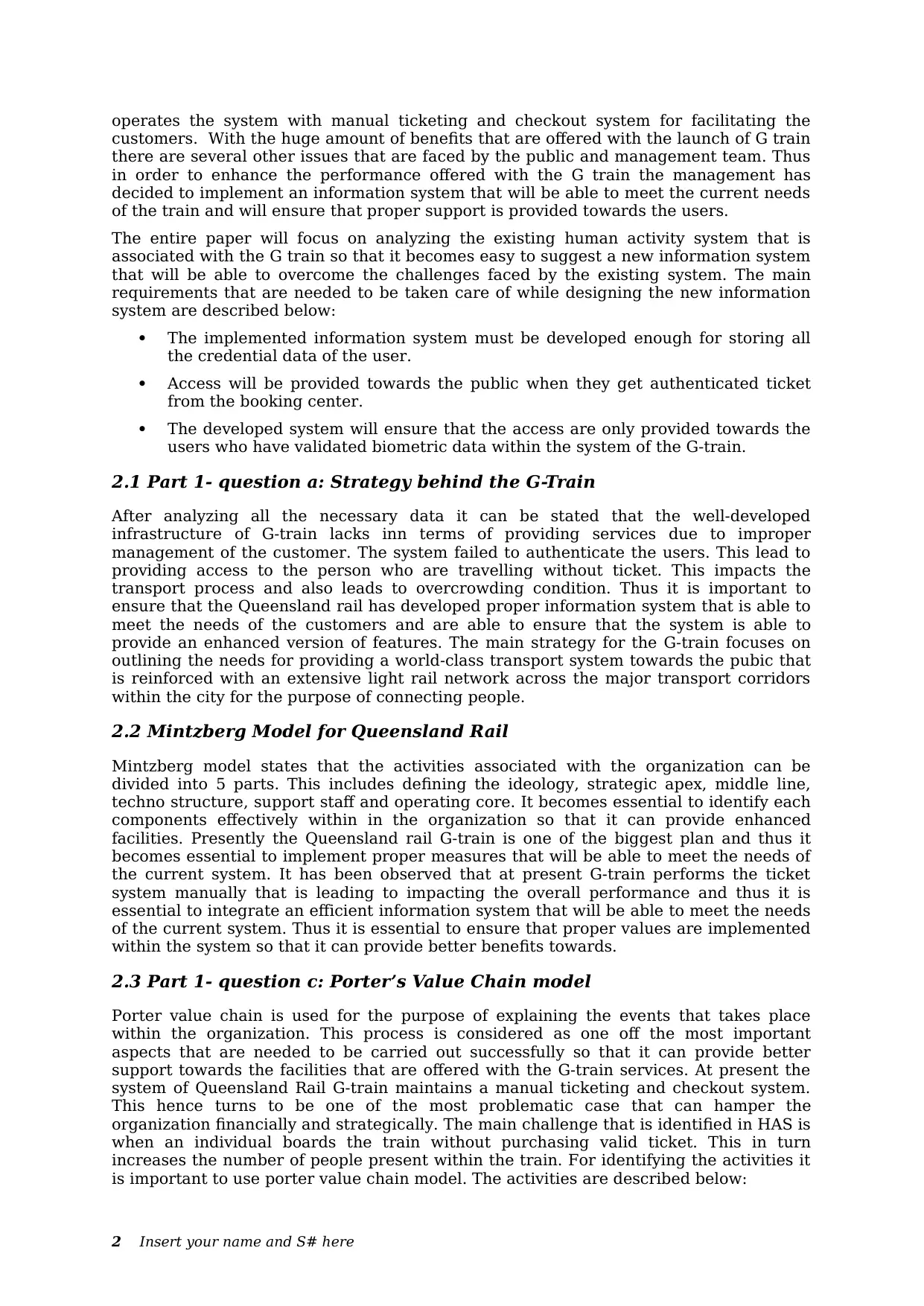
operates the system with manual ticketing and checkout system for facilitating the
customers. With the huge amount of benefits that are offered with the launch of G train
there are several other issues that are faced by the public and management team. Thus
in order to enhance the performance offered with the G train the management has
decided to implement an information system that will be able to meet the current needs
of the train and will ensure that proper support is provided towards the users.
The entire paper will focus on analyzing the existing human activity system that is
associated with the G train so that it becomes easy to suggest a new information system
that will be able to overcome the challenges faced by the existing system. The main
requirements that are needed to be taken care of while designing the new information
system are described below:
The implemented information system must be developed enough for storing all
the credential data of the user.
Access will be provided towards the public when they get authenticated ticket
from the booking center.
The developed system will ensure that the access are only provided towards the
users who have validated biometric data within the system of the G-train.
2.1 Part 1- question a: Strategy behind the G-Train
After analyzing all the necessary data it can be stated that the well-developed
infrastructure of G-train lacks inn terms of providing services due to improper
management of the customer. The system failed to authenticate the users. This lead to
providing access to the person who are travelling without ticket. This impacts the
transport process and also leads to overcrowding condition. Thus it is important to
ensure that the Queensland rail has developed proper information system that is able to
meet the needs of the customers and are able to ensure that the system is able to
provide an enhanced version of features. The main strategy for the G-train focuses on
outlining the needs for providing a world-class transport system towards the pubic that
is reinforced with an extensive light rail network across the major transport corridors
within the city for the purpose of connecting people.
2.2 Mintzberg Model for Queensland Rail
Mintzberg model states that the activities associated with the organization can be
divided into 5 parts. This includes defining the ideology, strategic apex, middle line,
techno structure, support staff and operating core. It becomes essential to identify each
components effectively within in the organization so that it can provide enhanced
facilities. Presently the Queensland rail G-train is one of the biggest plan and thus it
becomes essential to implement proper measures that will be able to meet the needs of
the current system. It has been observed that at present G-train performs the ticket
system manually that is leading to impacting the overall performance and thus it is
essential to integrate an efficient information system that will be able to meet the needs
of the current system. Thus it is essential to ensure that proper values are implemented
within the system so that it can provide better benefits towards.
2.3 Part 1- question c: Porter’s Value Chain model
Porter value chain is used for the purpose of explaining the events that takes place
within the organization. This process is considered as one off the most important
aspects that are needed to be carried out successfully so that it can provide better
support towards the facilities that are offered with the G-train services. At present the
system of Queensland Rail G-train maintains a manual ticketing and checkout system.
This hence turns to be one of the most problematic case that can hamper the
organization financially and strategically. The main challenge that is identified in HAS is
when an individual boards the train without purchasing valid ticket. This in turn
increases the number of people present within the train. For identifying the activities it
is important to use porter value chain model. The activities are described below:
2 Insert your name and S# here
customers. With the huge amount of benefits that are offered with the launch of G train
there are several other issues that are faced by the public and management team. Thus
in order to enhance the performance offered with the G train the management has
decided to implement an information system that will be able to meet the current needs
of the train and will ensure that proper support is provided towards the users.
The entire paper will focus on analyzing the existing human activity system that is
associated with the G train so that it becomes easy to suggest a new information system
that will be able to overcome the challenges faced by the existing system. The main
requirements that are needed to be taken care of while designing the new information
system are described below:
The implemented information system must be developed enough for storing all
the credential data of the user.
Access will be provided towards the public when they get authenticated ticket
from the booking center.
The developed system will ensure that the access are only provided towards the
users who have validated biometric data within the system of the G-train.
2.1 Part 1- question a: Strategy behind the G-Train
After analyzing all the necessary data it can be stated that the well-developed
infrastructure of G-train lacks inn terms of providing services due to improper
management of the customer. The system failed to authenticate the users. This lead to
providing access to the person who are travelling without ticket. This impacts the
transport process and also leads to overcrowding condition. Thus it is important to
ensure that the Queensland rail has developed proper information system that is able to
meet the needs of the customers and are able to ensure that the system is able to
provide an enhanced version of features. The main strategy for the G-train focuses on
outlining the needs for providing a world-class transport system towards the pubic that
is reinforced with an extensive light rail network across the major transport corridors
within the city for the purpose of connecting people.
2.2 Mintzberg Model for Queensland Rail
Mintzberg model states that the activities associated with the organization can be
divided into 5 parts. This includes defining the ideology, strategic apex, middle line,
techno structure, support staff and operating core. It becomes essential to identify each
components effectively within in the organization so that it can provide enhanced
facilities. Presently the Queensland rail G-train is one of the biggest plan and thus it
becomes essential to implement proper measures that will be able to meet the needs of
the current system. It has been observed that at present G-train performs the ticket
system manually that is leading to impacting the overall performance and thus it is
essential to integrate an efficient information system that will be able to meet the needs
of the current system. Thus it is essential to ensure that proper values are implemented
within the system so that it can provide better benefits towards.
2.3 Part 1- question c: Porter’s Value Chain model
Porter value chain is used for the purpose of explaining the events that takes place
within the organization. This process is considered as one off the most important
aspects that are needed to be carried out successfully so that it can provide better
support towards the facilities that are offered with the G-train services. At present the
system of Queensland Rail G-train maintains a manual ticketing and checkout system.
This hence turns to be one of the most problematic case that can hamper the
organization financially and strategically. The main challenge that is identified in HAS is
when an individual boards the train without purchasing valid ticket. This in turn
increases the number of people present within the train. For identifying the activities it
is important to use porter value chain model. The activities are described below:
2 Insert your name and S# here
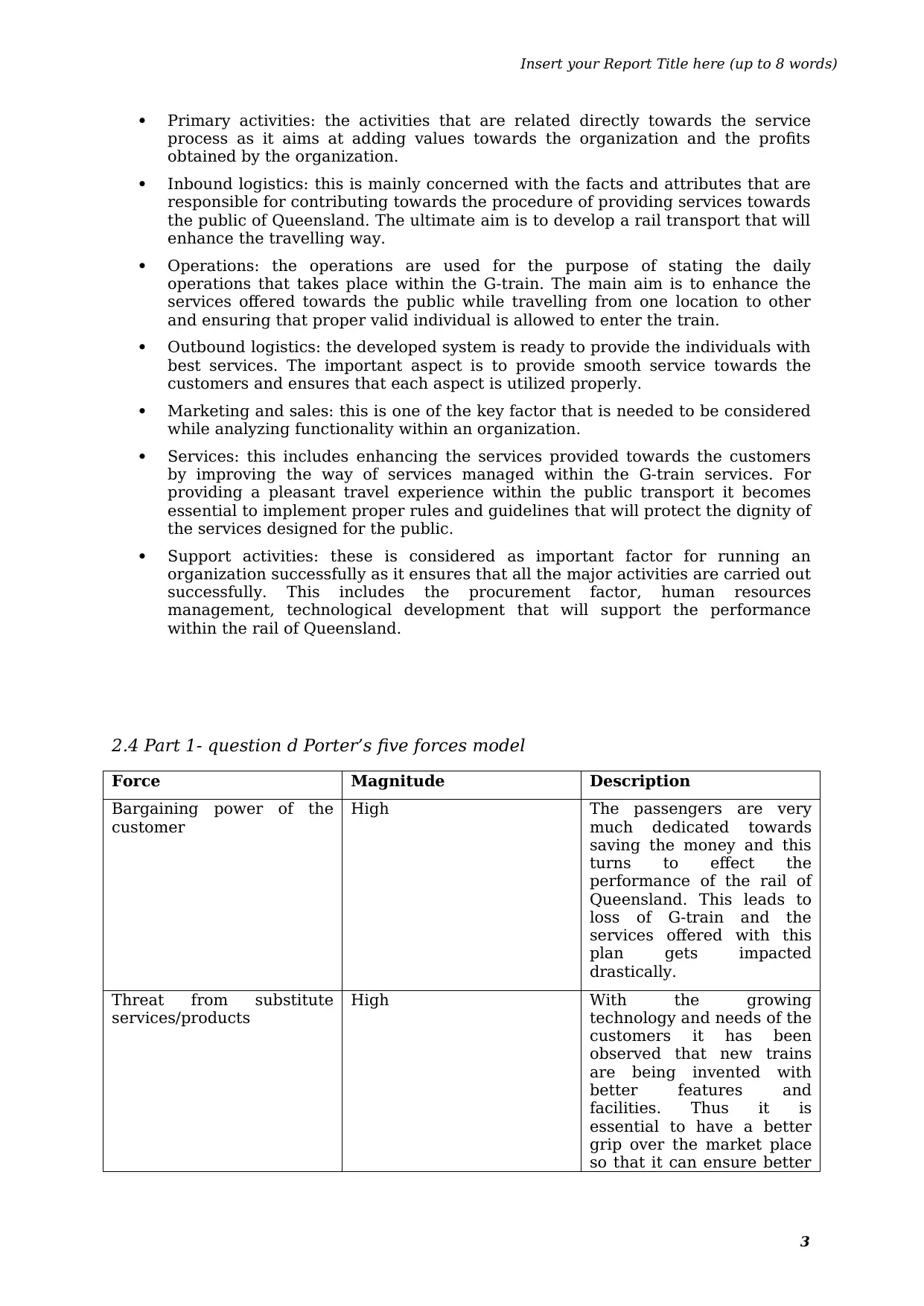
Insert your Report Title here (up to 8 words)
Primary activities: the activities that are related directly towards the service
process as it aims at adding values towards the organization and the profits
obtained by the organization.
Inbound logistics: this is mainly concerned with the facts and attributes that are
responsible for contributing towards the procedure of providing services towards
the public of Queensland. The ultimate aim is to develop a rail transport that will
enhance the travelling way.
Operations: the operations are used for the purpose of stating the daily
operations that takes place within the G-train. The main aim is to enhance the
services offered towards the public while travelling from one location to other
and ensuring that proper valid individual is allowed to enter the train.
Outbound logistics: the developed system is ready to provide the individuals with
best services. The important aspect is to provide smooth service towards the
customers and ensures that each aspect is utilized properly.
Marketing and sales: this is one of the key factor that is needed to be considered
while analyzing functionality within an organization.
Services: this includes enhancing the services provided towards the customers
by improving the way of services managed within the G-train services. For
providing a pleasant travel experience within the public transport it becomes
essential to implement proper rules and guidelines that will protect the dignity of
the services designed for the public.
Support activities: these is considered as important factor for running an
organization successfully as it ensures that all the major activities are carried out
successfully. This includes the procurement factor, human resources
management, technological development that will support the performance
within the rail of Queensland.
2.4 Part 1- question d Porter’s five forces model
Force Magnitude Description
Bargaining power of the
customer
High The passengers are very
much dedicated towards
saving the money and this
turns to effect the
performance of the rail of
Queensland. This leads to
loss of G-train and the
services offered with this
plan gets impacted
drastically.
Threat from substitute
services/products
High With the growing
technology and needs of the
customers it has been
observed that new trains
are being invented with
better features and
facilities. Thus it is
essential to have a better
grip over the market place
so that it can ensure better
3
Primary activities: the activities that are related directly towards the service
process as it aims at adding values towards the organization and the profits
obtained by the organization.
Inbound logistics: this is mainly concerned with the facts and attributes that are
responsible for contributing towards the procedure of providing services towards
the public of Queensland. The ultimate aim is to develop a rail transport that will
enhance the travelling way.
Operations: the operations are used for the purpose of stating the daily
operations that takes place within the G-train. The main aim is to enhance the
services offered towards the public while travelling from one location to other
and ensuring that proper valid individual is allowed to enter the train.
Outbound logistics: the developed system is ready to provide the individuals with
best services. The important aspect is to provide smooth service towards the
customers and ensures that each aspect is utilized properly.
Marketing and sales: this is one of the key factor that is needed to be considered
while analyzing functionality within an organization.
Services: this includes enhancing the services provided towards the customers
by improving the way of services managed within the G-train services. For
providing a pleasant travel experience within the public transport it becomes
essential to implement proper rules and guidelines that will protect the dignity of
the services designed for the public.
Support activities: these is considered as important factor for running an
organization successfully as it ensures that all the major activities are carried out
successfully. This includes the procurement factor, human resources
management, technological development that will support the performance
within the rail of Queensland.
2.4 Part 1- question d Porter’s five forces model
Force Magnitude Description
Bargaining power of the
customer
High The passengers are very
much dedicated towards
saving the money and this
turns to effect the
performance of the rail of
Queensland. This leads to
loss of G-train and the
services offered with this
plan gets impacted
drastically.
Threat from substitute
services/products
High With the growing
technology and needs of the
customers it has been
observed that new trains
are being invented with
better features and
facilities. Thus it is
essential to have a better
grip over the market place
so that it can ensure better
3
⊘ This is a preview!⊘
Do you want full access?
Subscribe today to unlock all pages.

Trusted by 1+ million students worldwide
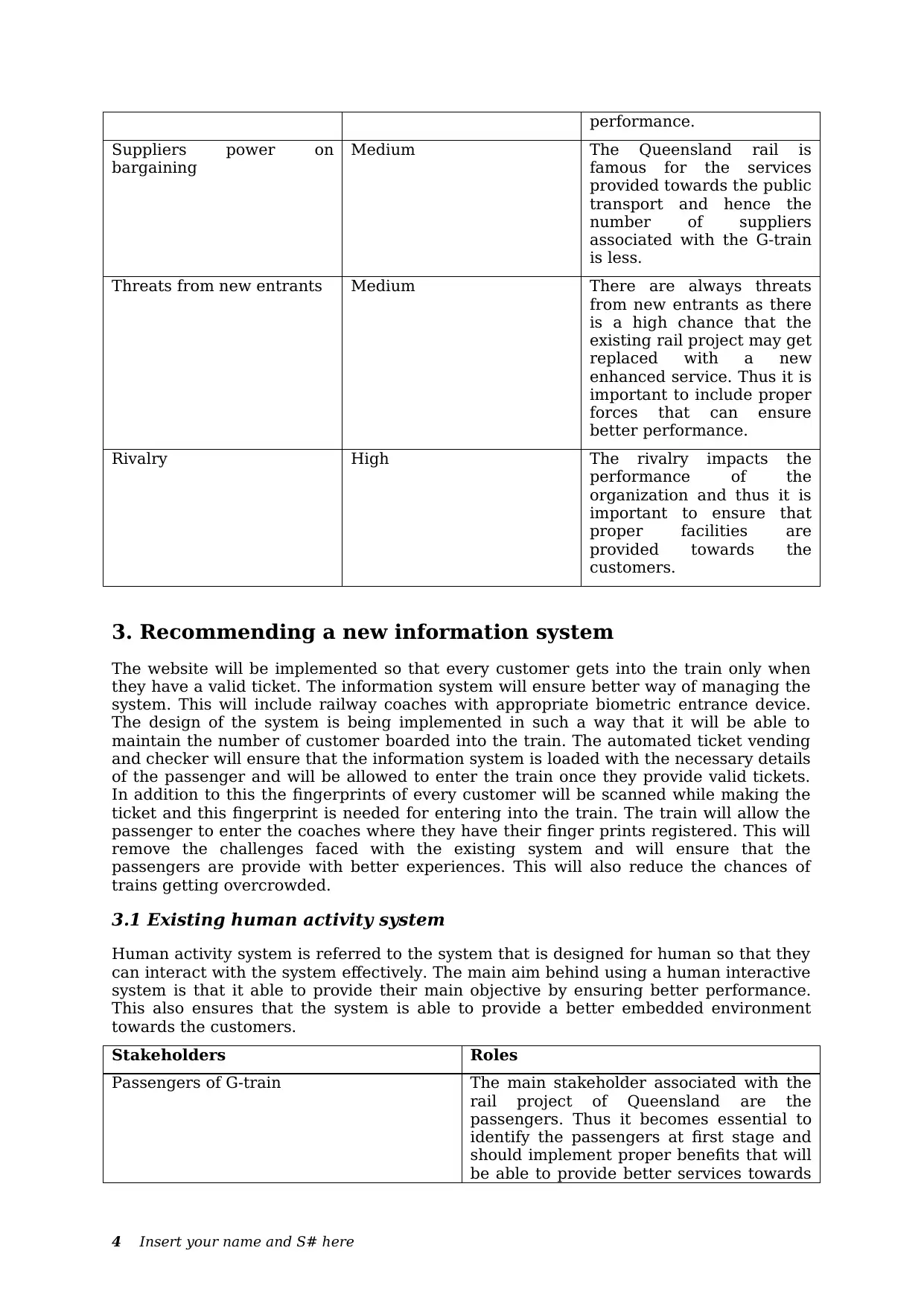
performance.
Suppliers power on
bargaining
Medium The Queensland rail is
famous for the services
provided towards the public
transport and hence the
number of suppliers
associated with the G-train
is less.
Threats from new entrants Medium There are always threats
from new entrants as there
is a high chance that the
existing rail project may get
replaced with a new
enhanced service. Thus it is
important to include proper
forces that can ensure
better performance.
Rivalry High The rivalry impacts the
performance of the
organization and thus it is
important to ensure that
proper facilities are
provided towards the
customers.
3. Recommending a new information system
The website will be implemented so that every customer gets into the train only when
they have a valid ticket. The information system will ensure better way of managing the
system. This will include railway coaches with appropriate biometric entrance device.
The design of the system is being implemented in such a way that it will be able to
maintain the number of customer boarded into the train. The automated ticket vending
and checker will ensure that the information system is loaded with the necessary details
of the passenger and will be allowed to enter the train once they provide valid tickets.
In addition to this the fingerprints of every customer will be scanned while making the
ticket and this fingerprint is needed for entering into the train. The train will allow the
passenger to enter the coaches where they have their finger prints registered. This will
remove the challenges faced with the existing system and will ensure that the
passengers are provide with better experiences. This will also reduce the chances of
trains getting overcrowded.
3.1 Existing human activity system
Human activity system is referred to the system that is designed for human so that they
can interact with the system effectively. The main aim behind using a human interactive
system is that it able to provide their main objective by ensuring better performance.
This also ensures that the system is able to provide a better embedded environment
towards the customers.
Stakeholders Roles
Passengers of G-train The main stakeholder associated with the
rail project of Queensland are the
passengers. Thus it becomes essential to
identify the passengers at first stage and
should implement proper benefits that will
be able to provide better services towards
4 Insert your name and S# here
Suppliers power on
bargaining
Medium The Queensland rail is
famous for the services
provided towards the public
transport and hence the
number of suppliers
associated with the G-train
is less.
Threats from new entrants Medium There are always threats
from new entrants as there
is a high chance that the
existing rail project may get
replaced with a new
enhanced service. Thus it is
important to include proper
forces that can ensure
better performance.
Rivalry High The rivalry impacts the
performance of the
organization and thus it is
important to ensure that
proper facilities are
provided towards the
customers.
3. Recommending a new information system
The website will be implemented so that every customer gets into the train only when
they have a valid ticket. The information system will ensure better way of managing the
system. This will include railway coaches with appropriate biometric entrance device.
The design of the system is being implemented in such a way that it will be able to
maintain the number of customer boarded into the train. The automated ticket vending
and checker will ensure that the information system is loaded with the necessary details
of the passenger and will be allowed to enter the train once they provide valid tickets.
In addition to this the fingerprints of every customer will be scanned while making the
ticket and this fingerprint is needed for entering into the train. The train will allow the
passenger to enter the coaches where they have their finger prints registered. This will
remove the challenges faced with the existing system and will ensure that the
passengers are provide with better experiences. This will also reduce the chances of
trains getting overcrowded.
3.1 Existing human activity system
Human activity system is referred to the system that is designed for human so that they
can interact with the system effectively. The main aim behind using a human interactive
system is that it able to provide their main objective by ensuring better performance.
This also ensures that the system is able to provide a better embedded environment
towards the customers.
Stakeholders Roles
Passengers of G-train The main stakeholder associated with the
rail project of Queensland are the
passengers. Thus it becomes essential to
identify the passengers at first stage and
should implement proper benefits that will
be able to provide better services towards
4 Insert your name and S# here
Paraphrase This Document
Need a fresh take? Get an instant paraphrase of this document with our AI Paraphraser
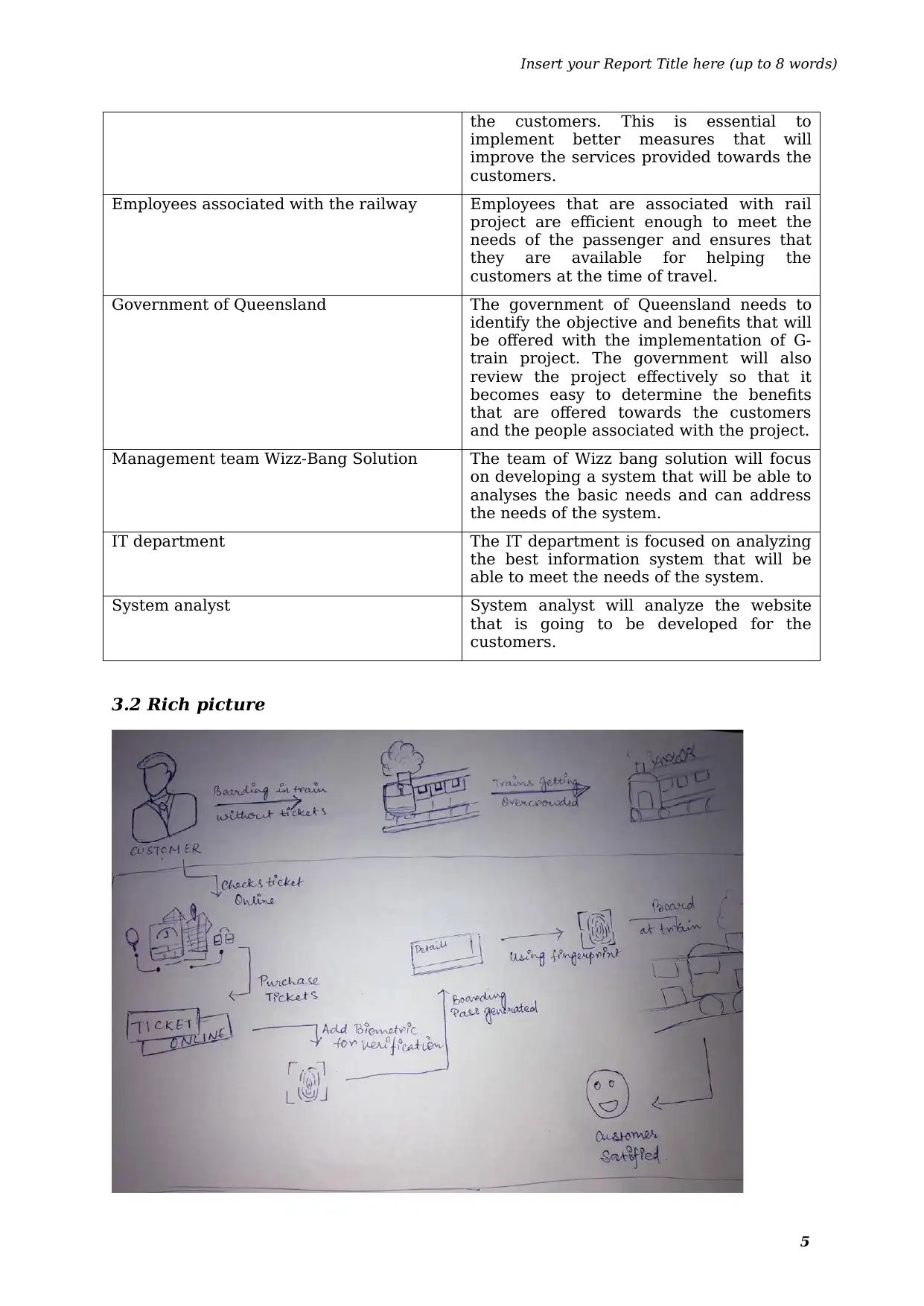
Insert your Report Title here (up to 8 words)
the customers. This is essential to
implement better measures that will
improve the services provided towards the
customers.
Employees associated with the railway Employees that are associated with rail
project are efficient enough to meet the
needs of the passenger and ensures that
they are available for helping the
customers at the time of travel.
Government of Queensland The government of Queensland needs to
identify the objective and benefits that will
be offered with the implementation of G-
train project. The government will also
review the project effectively so that it
becomes easy to determine the benefits
that are offered towards the customers
and the people associated with the project.
Management team Wizz-Bang Solution The team of Wizz bang solution will focus
on developing a system that will be able to
analyses the basic needs and can address
the needs of the system.
IT department The IT department is focused on analyzing
the best information system that will be
able to meet the needs of the system.
System analyst System analyst will analyze the website
that is going to be developed for the
customers.
3.2 Rich picture
5
the customers. This is essential to
implement better measures that will
improve the services provided towards the
customers.
Employees associated with the railway Employees that are associated with rail
project are efficient enough to meet the
needs of the passenger and ensures that
they are available for helping the
customers at the time of travel.
Government of Queensland The government of Queensland needs to
identify the objective and benefits that will
be offered with the implementation of G-
train project. The government will also
review the project effectively so that it
becomes easy to determine the benefits
that are offered towards the customers
and the people associated with the project.
Management team Wizz-Bang Solution The team of Wizz bang solution will focus
on developing a system that will be able to
analyses the basic needs and can address
the needs of the system.
IT department The IT department is focused on analyzing
the best information system that will be
able to meet the needs of the system.
System analyst System analyst will analyze the website
that is going to be developed for the
customers.
3.2 Rich picture
5
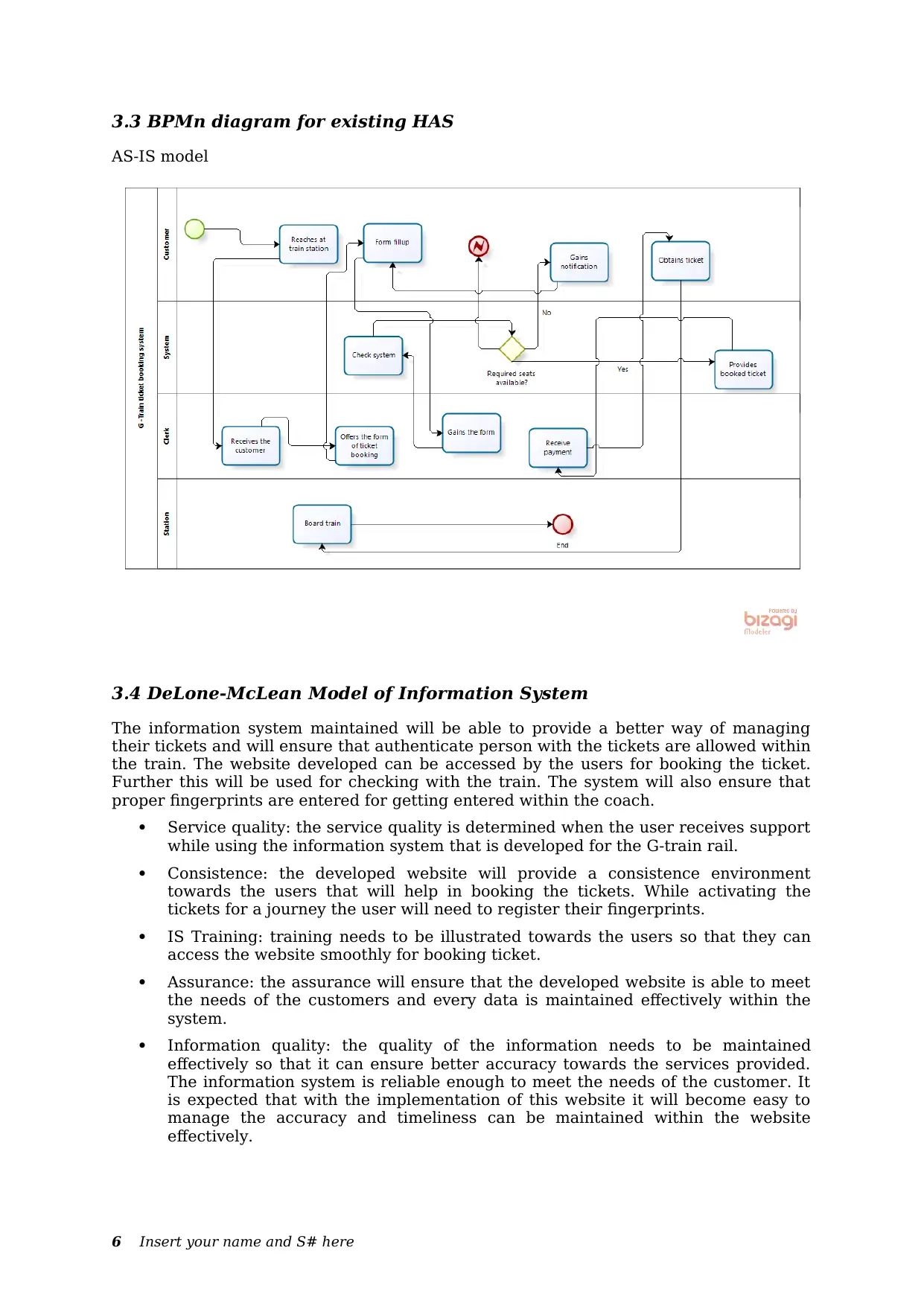
3.3 BPMn diagram for existing HAS
AS-IS model
3.4 DeLone-McLean Model of Information System
The information system maintained will be able to provide a better way of managing
their tickets and will ensure that authenticate person with the tickets are allowed within
the train. The website developed can be accessed by the users for booking the ticket.
Further this will be used for checking with the train. The system will also ensure that
proper fingerprints are entered for getting entered within the coach.
Service quality: the service quality is determined when the user receives support
while using the information system that is developed for the G-train rail.
Consistence: the developed website will provide a consistence environment
towards the users that will help in booking the tickets. While activating the
tickets for a journey the user will need to register their fingerprints.
IS Training: training needs to be illustrated towards the users so that they can
access the website smoothly for booking ticket.
Assurance: the assurance will ensure that the developed website is able to meet
the needs of the customers and every data is maintained effectively within the
system.
Information quality: the quality of the information needs to be maintained
effectively so that it can ensure better accuracy towards the services provided.
The information system is reliable enough to meet the needs of the customer. It
is expected that with the implementation of this website it will become easy to
manage the accuracy and timeliness can be maintained within the website
effectively.
6 Insert your name and S# here
AS-IS model
3.4 DeLone-McLean Model of Information System
The information system maintained will be able to provide a better way of managing
their tickets and will ensure that authenticate person with the tickets are allowed within
the train. The website developed can be accessed by the users for booking the ticket.
Further this will be used for checking with the train. The system will also ensure that
proper fingerprints are entered for getting entered within the coach.
Service quality: the service quality is determined when the user receives support
while using the information system that is developed for the G-train rail.
Consistence: the developed website will provide a consistence environment
towards the users that will help in booking the tickets. While activating the
tickets for a journey the user will need to register their fingerprints.
IS Training: training needs to be illustrated towards the users so that they can
access the website smoothly for booking ticket.
Assurance: the assurance will ensure that the developed website is able to meet
the needs of the customers and every data is maintained effectively within the
system.
Information quality: the quality of the information needs to be maintained
effectively so that it can ensure better accuracy towards the services provided.
The information system is reliable enough to meet the needs of the customer. It
is expected that with the implementation of this website it will become easy to
manage the accuracy and timeliness can be maintained within the website
effectively.
6 Insert your name and S# here
⊘ This is a preview!⊘
Do you want full access?
Subscribe today to unlock all pages.

Trusted by 1+ million students worldwide
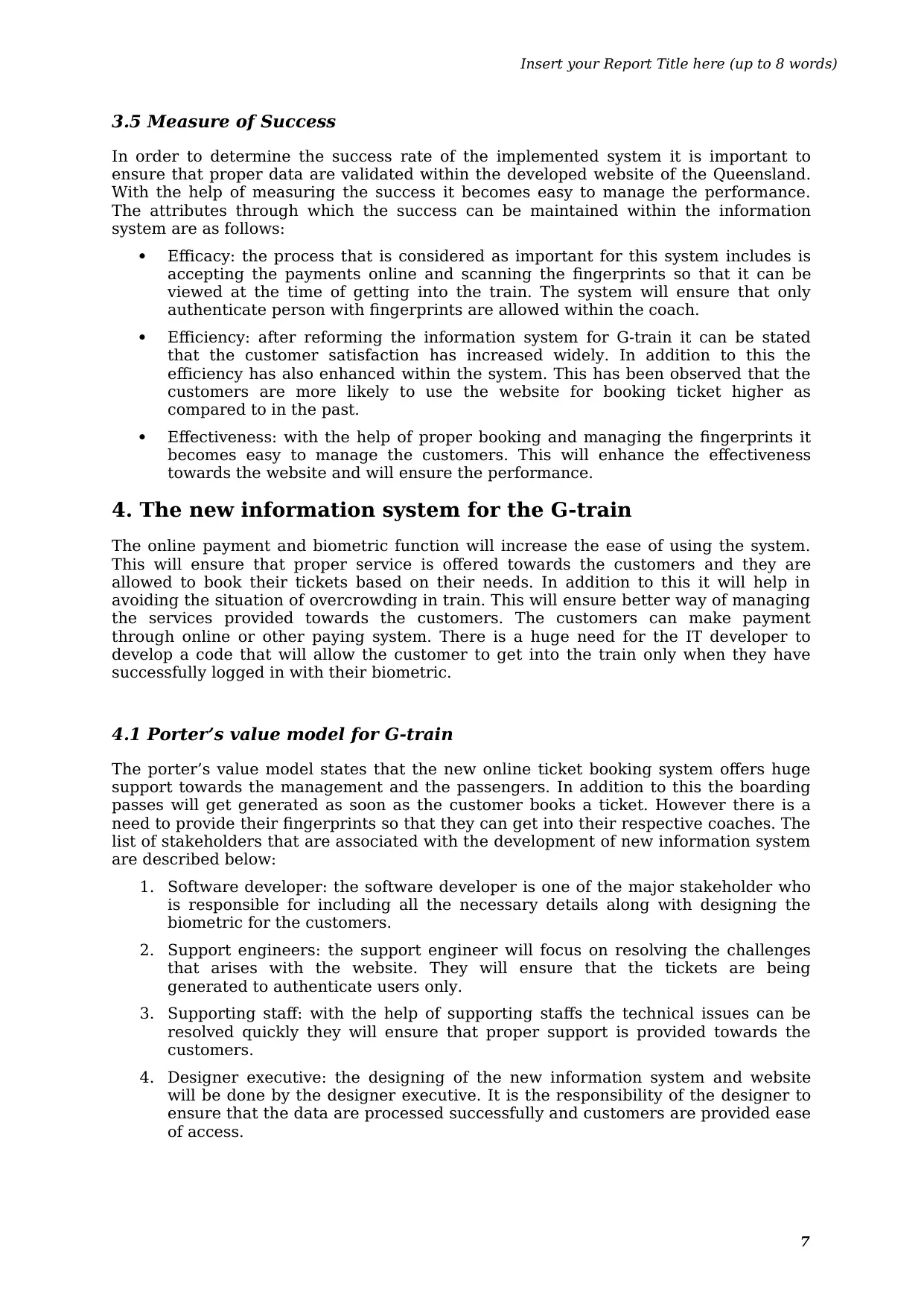
Insert your Report Title here (up to 8 words)
3.5 Measure of Success
In order to determine the success rate of the implemented system it is important to
ensure that proper data are validated within the developed website of the Queensland.
With the help of measuring the success it becomes easy to manage the performance.
The attributes through which the success can be maintained within the information
system are as follows:
Efficacy: the process that is considered as important for this system includes is
accepting the payments online and scanning the fingerprints so that it can be
viewed at the time of getting into the train. The system will ensure that only
authenticate person with fingerprints are allowed within the coach.
Efficiency: after reforming the information system for G-train it can be stated
that the customer satisfaction has increased widely. In addition to this the
efficiency has also enhanced within the system. This has been observed that the
customers are more likely to use the website for booking ticket higher as
compared to in the past.
Effectiveness: with the help of proper booking and managing the fingerprints it
becomes easy to manage the customers. This will enhance the effectiveness
towards the website and will ensure the performance.
4. The new information system for the G-train
The online payment and biometric function will increase the ease of using the system.
This will ensure that proper service is offered towards the customers and they are
allowed to book their tickets based on their needs. In addition to this it will help in
avoiding the situation of overcrowding in train. This will ensure better way of managing
the services provided towards the customers. The customers can make payment
through online or other paying system. There is a huge need for the IT developer to
develop a code that will allow the customer to get into the train only when they have
successfully logged in with their biometric.
4.1 Porter’s value model for G-train
The porter’s value model states that the new online ticket booking system offers huge
support towards the management and the passengers. In addition to this the boarding
passes will get generated as soon as the customer books a ticket. However there is a
need to provide their fingerprints so that they can get into their respective coaches. The
list of stakeholders that are associated with the development of new information system
are described below:
1. Software developer: the software developer is one of the major stakeholder who
is responsible for including all the necessary details along with designing the
biometric for the customers.
2. Support engineers: the support engineer will focus on resolving the challenges
that arises with the website. They will ensure that the tickets are being
generated to authenticate users only.
3. Supporting staff: with the help of supporting staffs the technical issues can be
resolved quickly they will ensure that proper support is provided towards the
customers.
4. Designer executive: the designing of the new information system and website
will be done by the designer executive. It is the responsibility of the designer to
ensure that the data are processed successfully and customers are provided ease
of access.
7
3.5 Measure of Success
In order to determine the success rate of the implemented system it is important to
ensure that proper data are validated within the developed website of the Queensland.
With the help of measuring the success it becomes easy to manage the performance.
The attributes through which the success can be maintained within the information
system are as follows:
Efficacy: the process that is considered as important for this system includes is
accepting the payments online and scanning the fingerprints so that it can be
viewed at the time of getting into the train. The system will ensure that only
authenticate person with fingerprints are allowed within the coach.
Efficiency: after reforming the information system for G-train it can be stated
that the customer satisfaction has increased widely. In addition to this the
efficiency has also enhanced within the system. This has been observed that the
customers are more likely to use the website for booking ticket higher as
compared to in the past.
Effectiveness: with the help of proper booking and managing the fingerprints it
becomes easy to manage the customers. This will enhance the effectiveness
towards the website and will ensure the performance.
4. The new information system for the G-train
The online payment and biometric function will increase the ease of using the system.
This will ensure that proper service is offered towards the customers and they are
allowed to book their tickets based on their needs. In addition to this it will help in
avoiding the situation of overcrowding in train. This will ensure better way of managing
the services provided towards the customers. The customers can make payment
through online or other paying system. There is a huge need for the IT developer to
develop a code that will allow the customer to get into the train only when they have
successfully logged in with their biometric.
4.1 Porter’s value model for G-train
The porter’s value model states that the new online ticket booking system offers huge
support towards the management and the passengers. In addition to this the boarding
passes will get generated as soon as the customer books a ticket. However there is a
need to provide their fingerprints so that they can get into their respective coaches. The
list of stakeholders that are associated with the development of new information system
are described below:
1. Software developer: the software developer is one of the major stakeholder who
is responsible for including all the necessary details along with designing the
biometric for the customers.
2. Support engineers: the support engineer will focus on resolving the challenges
that arises with the website. They will ensure that the tickets are being
generated to authenticate users only.
3. Supporting staff: with the help of supporting staffs the technical issues can be
resolved quickly they will ensure that proper support is provided towards the
customers.
4. Designer executive: the designing of the new information system and website
will be done by the designer executive. It is the responsibility of the designer to
ensure that the data are processed successfully and customers are provided ease
of access.
7
Paraphrase This Document
Need a fresh take? Get an instant paraphrase of this document with our AI Paraphraser
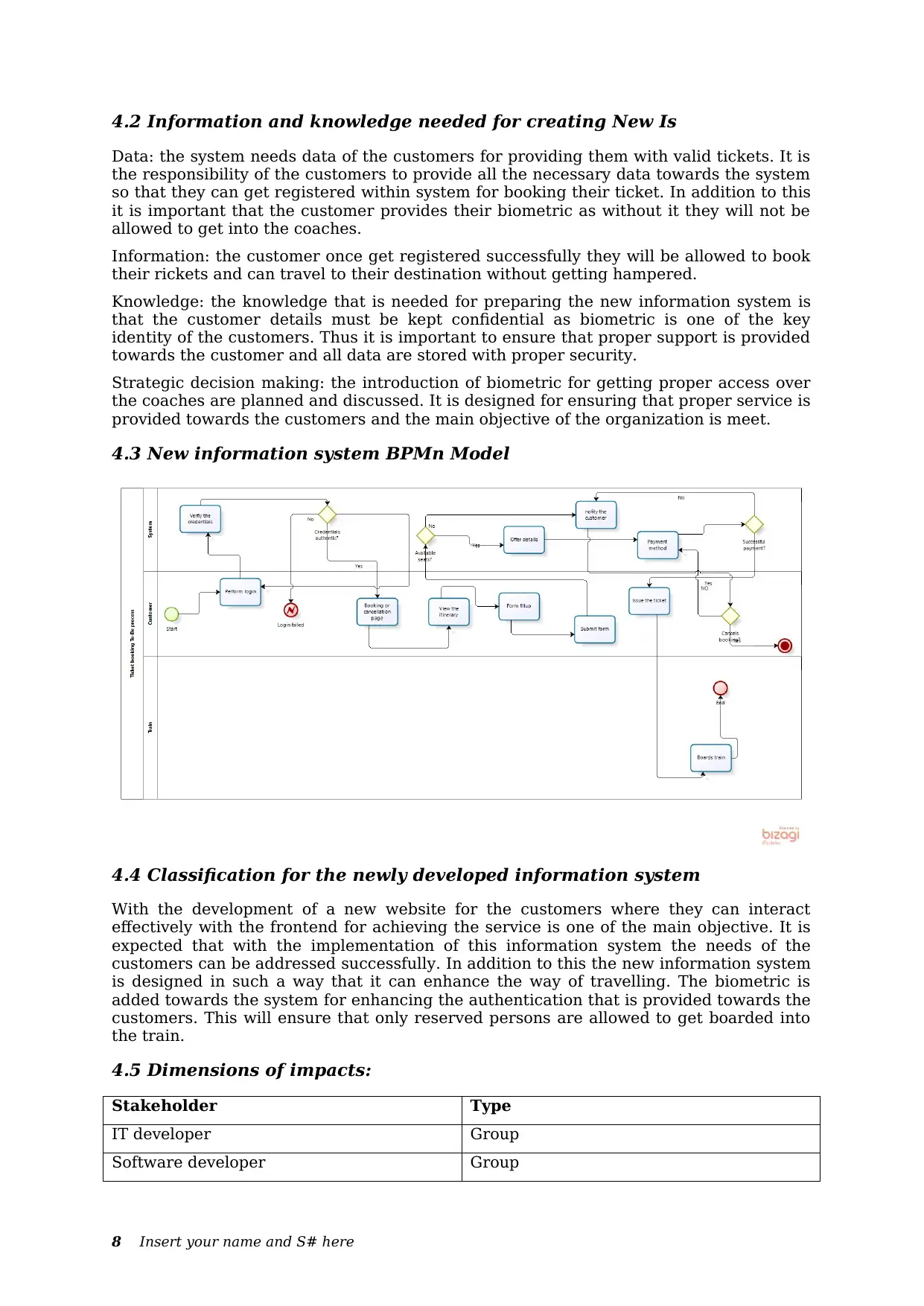
4.2 Information and knowledge needed for creating New Is
Data: the system needs data of the customers for providing them with valid tickets. It is
the responsibility of the customers to provide all the necessary data towards the system
so that they can get registered within system for booking their ticket. In addition to this
it is important that the customer provides their biometric as without it they will not be
allowed to get into the coaches.
Information: the customer once get registered successfully they will be allowed to book
their rickets and can travel to their destination without getting hampered.
Knowledge: the knowledge that is needed for preparing the new information system is
that the customer details must be kept confidential as biometric is one of the key
identity of the customers. Thus it is important to ensure that proper support is provided
towards the customer and all data are stored with proper security.
Strategic decision making: the introduction of biometric for getting proper access over
the coaches are planned and discussed. It is designed for ensuring that proper service is
provided towards the customers and the main objective of the organization is meet.
4.3 New information system BPMn Model
4.4 Classification for the newly developed information system
With the development of a new website for the customers where they can interact
effectively with the frontend for achieving the service is one of the main objective. It is
expected that with the implementation of this information system the needs of the
customers can be addressed successfully. In addition to this the new information system
is designed in such a way that it can enhance the way of travelling. The biometric is
added towards the system for enhancing the authentication that is provided towards the
customers. This will ensure that only reserved persons are allowed to get boarded into
the train.
4.5 Dimensions of impacts:
Stakeholder Type
IT developer Group
Software developer Group
8 Insert your name and S# here
Data: the system needs data of the customers for providing them with valid tickets. It is
the responsibility of the customers to provide all the necessary data towards the system
so that they can get registered within system for booking their ticket. In addition to this
it is important that the customer provides their biometric as without it they will not be
allowed to get into the coaches.
Information: the customer once get registered successfully they will be allowed to book
their rickets and can travel to their destination without getting hampered.
Knowledge: the knowledge that is needed for preparing the new information system is
that the customer details must be kept confidential as biometric is one of the key
identity of the customers. Thus it is important to ensure that proper support is provided
towards the customer and all data are stored with proper security.
Strategic decision making: the introduction of biometric for getting proper access over
the coaches are planned and discussed. It is designed for ensuring that proper service is
provided towards the customers and the main objective of the organization is meet.
4.3 New information system BPMn Model
4.4 Classification for the newly developed information system
With the development of a new website for the customers where they can interact
effectively with the frontend for achieving the service is one of the main objective. It is
expected that with the implementation of this information system the needs of the
customers can be addressed successfully. In addition to this the new information system
is designed in such a way that it can enhance the way of travelling. The biometric is
added towards the system for enhancing the authentication that is provided towards the
customers. This will ensure that only reserved persons are allowed to get boarded into
the train.
4.5 Dimensions of impacts:
Stakeholder Type
IT developer Group
Software developer Group
8 Insert your name and S# here
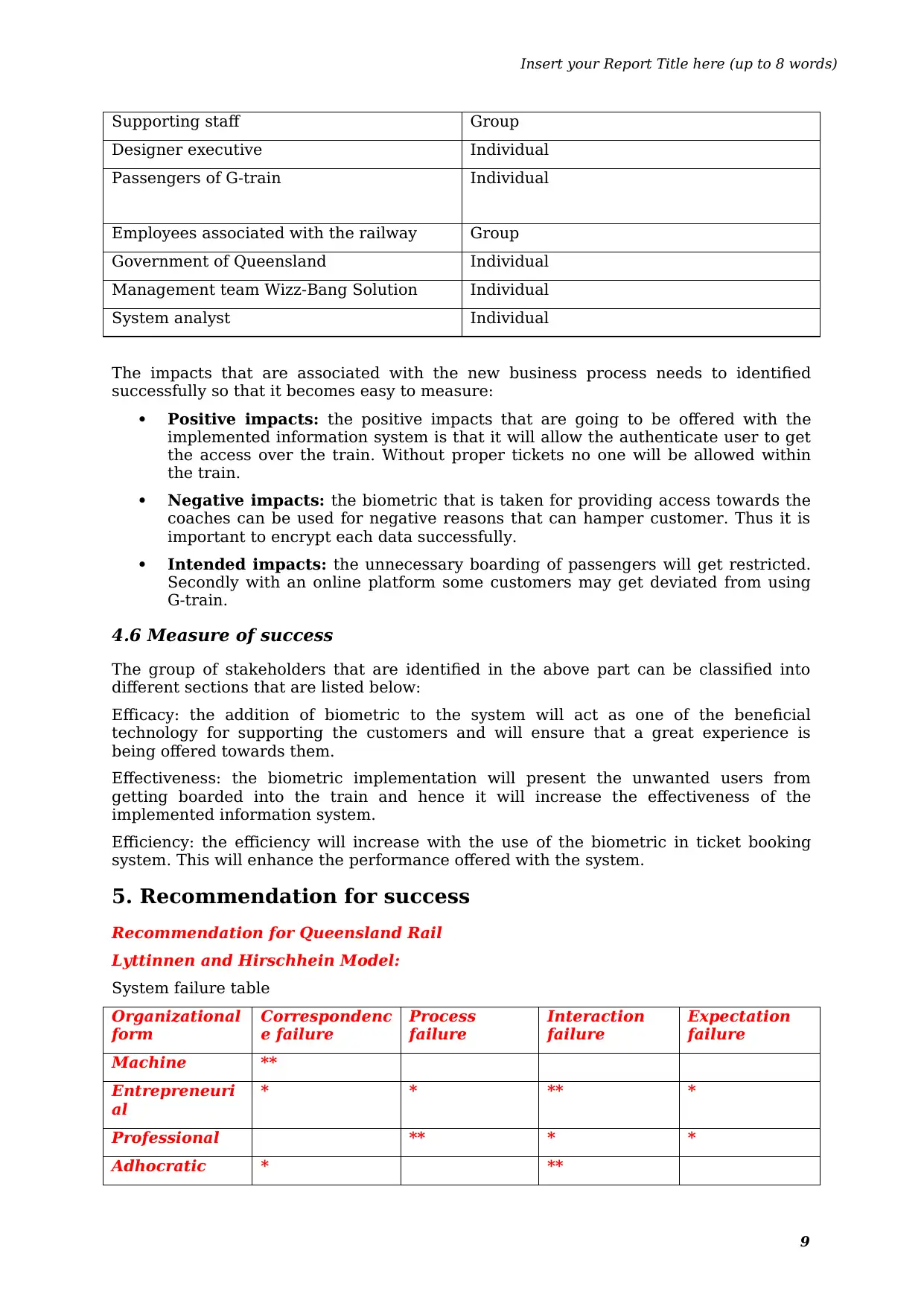
Insert your Report Title here (up to 8 words)
Supporting staff Group
Designer executive Individual
Passengers of G-train Individual
Employees associated with the railway Group
Government of Queensland Individual
Management team Wizz-Bang Solution Individual
System analyst Individual
The impacts that are associated with the new business process needs to identified
successfully so that it becomes easy to measure:
Positive impacts: the positive impacts that are going to be offered with the
implemented information system is that it will allow the authenticate user to get
the access over the train. Without proper tickets no one will be allowed within
the train.
Negative impacts: the biometric that is taken for providing access towards the
coaches can be used for negative reasons that can hamper customer. Thus it is
important to encrypt each data successfully.
Intended impacts: the unnecessary boarding of passengers will get restricted.
Secondly with an online platform some customers may get deviated from using
G-train.
4.6 Measure of success
The group of stakeholders that are identified in the above part can be classified into
different sections that are listed below:
Efficacy: the addition of biometric to the system will act as one of the beneficial
technology for supporting the customers and will ensure that a great experience is
being offered towards them.
Effectiveness: the biometric implementation will present the unwanted users from
getting boarded into the train and hence it will increase the effectiveness of the
implemented information system.
Efficiency: the efficiency will increase with the use of the biometric in ticket booking
system. This will enhance the performance offered with the system.
5. Recommendation for success
Recommendation for Queensland Rail
Lyttinnen and Hirschhein Model:
System failure table
Organizational
form
Correspondenc
e failure
Process
failure
Interaction
failure
Expectation
failure
Machine **
Entrepreneuri
al
* * ** *
Professional ** * *
Adhocratic * **
9
Supporting staff Group
Designer executive Individual
Passengers of G-train Individual
Employees associated with the railway Group
Government of Queensland Individual
Management team Wizz-Bang Solution Individual
System analyst Individual
The impacts that are associated with the new business process needs to identified
successfully so that it becomes easy to measure:
Positive impacts: the positive impacts that are going to be offered with the
implemented information system is that it will allow the authenticate user to get
the access over the train. Without proper tickets no one will be allowed within
the train.
Negative impacts: the biometric that is taken for providing access towards the
coaches can be used for negative reasons that can hamper customer. Thus it is
important to encrypt each data successfully.
Intended impacts: the unnecessary boarding of passengers will get restricted.
Secondly with an online platform some customers may get deviated from using
G-train.
4.6 Measure of success
The group of stakeholders that are identified in the above part can be classified into
different sections that are listed below:
Efficacy: the addition of biometric to the system will act as one of the beneficial
technology for supporting the customers and will ensure that a great experience is
being offered towards them.
Effectiveness: the biometric implementation will present the unwanted users from
getting boarded into the train and hence it will increase the effectiveness of the
implemented information system.
Efficiency: the efficiency will increase with the use of the biometric in ticket booking
system. This will enhance the performance offered with the system.
5. Recommendation for success
Recommendation for Queensland Rail
Lyttinnen and Hirschhein Model:
System failure table
Organizational
form
Correspondenc
e failure
Process
failure
Interaction
failure
Expectation
failure
Machine **
Entrepreneuri
al
* * ** *
Professional ** * *
Adhocratic * **
9
⊘ This is a preview!⊘
Do you want full access?
Subscribe today to unlock all pages.

Trusted by 1+ million students worldwide
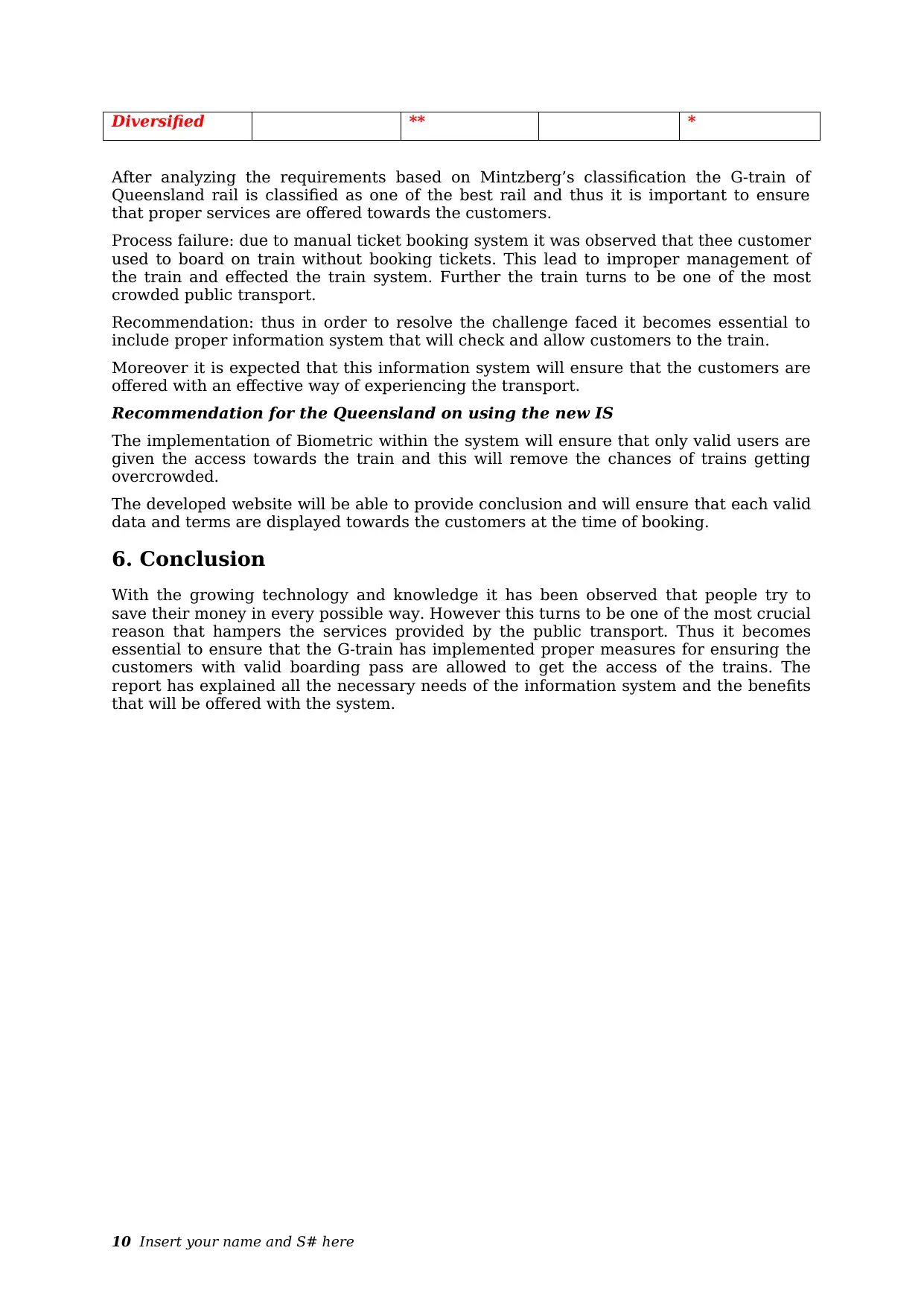
Diversified ** *
After analyzing the requirements based on Mintzberg’s classification the G-train of
Queensland rail is classified as one of the best rail and thus it is important to ensure
that proper services are offered towards the customers.
Process failure: due to manual ticket booking system it was observed that thee customer
used to board on train without booking tickets. This lead to improper management of
the train and effected the train system. Further the train turns to be one of the most
crowded public transport.
Recommendation: thus in order to resolve the challenge faced it becomes essential to
include proper information system that will check and allow customers to the train.
Moreover it is expected that this information system will ensure that the customers are
offered with an effective way of experiencing the transport.
Recommendation for the Queensland on using the new IS
The implementation of Biometric within the system will ensure that only valid users are
given the access towards the train and this will remove the chances of trains getting
overcrowded.
The developed website will be able to provide conclusion and will ensure that each valid
data and terms are displayed towards the customers at the time of booking.
6. Conclusion
With the growing technology and knowledge it has been observed that people try to
save their money in every possible way. However this turns to be one of the most crucial
reason that hampers the services provided by the public transport. Thus it becomes
essential to ensure that the G-train has implemented proper measures for ensuring the
customers with valid boarding pass are allowed to get the access of the trains. The
report has explained all the necessary needs of the information system and the benefits
that will be offered with the system.
10 Insert your name and S# here
After analyzing the requirements based on Mintzberg’s classification the G-train of
Queensland rail is classified as one of the best rail and thus it is important to ensure
that proper services are offered towards the customers.
Process failure: due to manual ticket booking system it was observed that thee customer
used to board on train without booking tickets. This lead to improper management of
the train and effected the train system. Further the train turns to be one of the most
crowded public transport.
Recommendation: thus in order to resolve the challenge faced it becomes essential to
include proper information system that will check and allow customers to the train.
Moreover it is expected that this information system will ensure that the customers are
offered with an effective way of experiencing the transport.
Recommendation for the Queensland on using the new IS
The implementation of Biometric within the system will ensure that only valid users are
given the access towards the train and this will remove the chances of trains getting
overcrowded.
The developed website will be able to provide conclusion and will ensure that each valid
data and terms are displayed towards the customers at the time of booking.
6. Conclusion
With the growing technology and knowledge it has been observed that people try to
save their money in every possible way. However this turns to be one of the most crucial
reason that hampers the services provided by the public transport. Thus it becomes
essential to ensure that the G-train has implemented proper measures for ensuring the
customers with valid boarding pass are allowed to get the access of the trains. The
report has explained all the necessary needs of the information system and the benefits
that will be offered with the system.
10 Insert your name and S# here
Paraphrase This Document
Need a fresh take? Get an instant paraphrase of this document with our AI Paraphraser
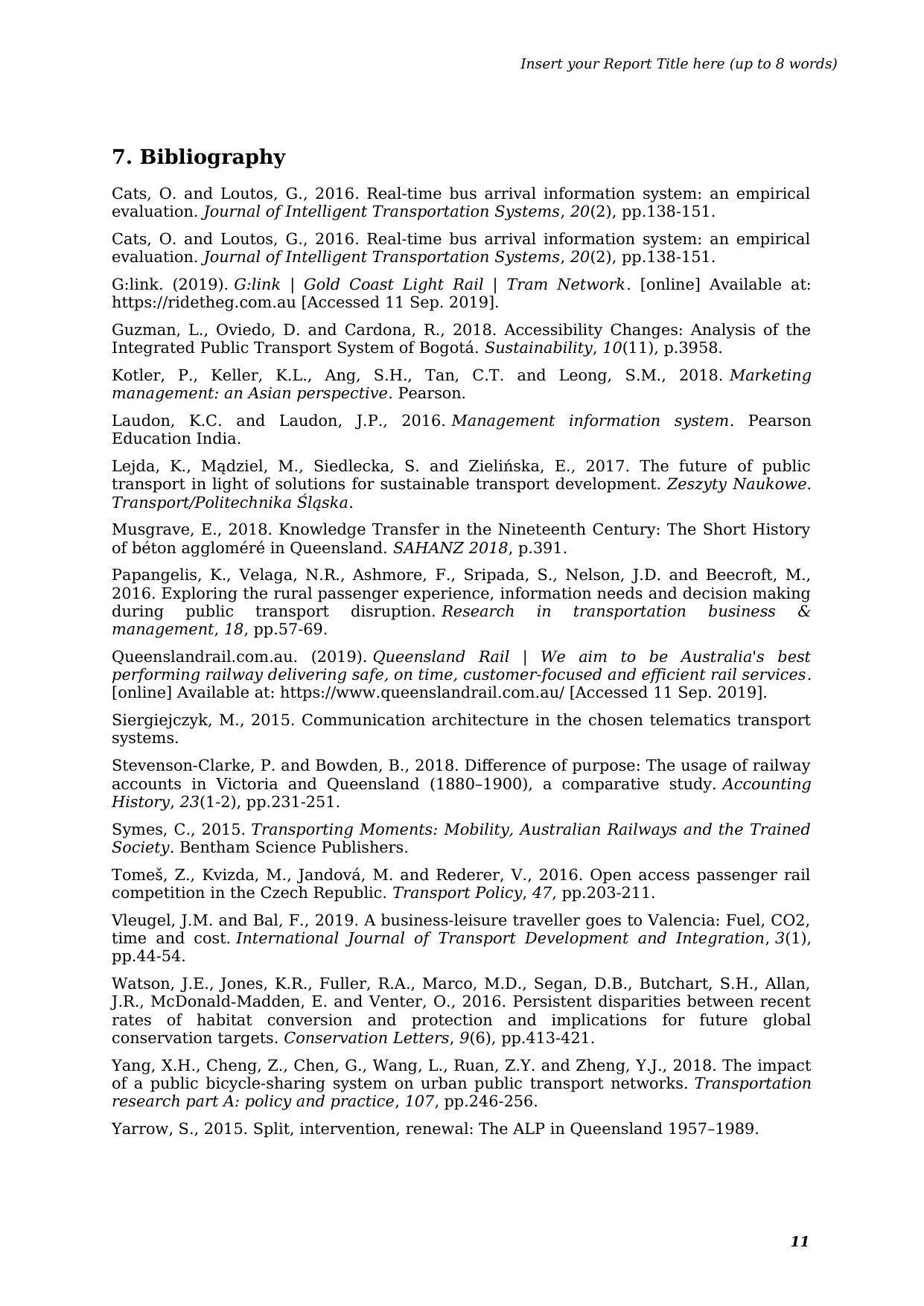
Insert your Report Title here (up to 8 words)
7. Bibliography
Cats, O. and Loutos, G., 2016. Real-time bus arrival information system: an empirical
evaluation. Journal of Intelligent Transportation Systems, 20(2), pp.138-151.
Cats, O. and Loutos, G., 2016. Real-time bus arrival information system: an empirical
evaluation. Journal of Intelligent Transportation Systems, 20(2), pp.138-151.
G:link. (2019). G:link | Gold Coast Light Rail | Tram Network. [online] Available at:
https://ridetheg.com.au [Accessed 11 Sep. 2019].
Guzman, L., Oviedo, D. and Cardona, R., 2018. Accessibility Changes: Analysis of the
Integrated Public Transport System of Bogotá. Sustainability, 10(11), p.3958.
Kotler, P., Keller, K.L., Ang, S.H., Tan, C.T. and Leong, S.M., 2018. Marketing
management: an Asian perspective. Pearson.
Laudon, K.C. and Laudon, J.P., 2016. Management information system. Pearson
Education India.
Lejda, K., Mądziel, M., Siedlecka, S. and Zielińska, E., 2017. The future of public
transport in light of solutions for sustainable transport development. Zeszyty Naukowe.
Transport/Politechnika Śląska.
Musgrave, E., 2018. Knowledge Transfer in the Nineteenth Century: The Short History
of béton aggloméré in Queensland. SAHANZ 2018, p.391.
Papangelis, K., Velaga, N.R., Ashmore, F., Sripada, S., Nelson, J.D. and Beecroft, M.,
2016. Exploring the rural passenger experience, information needs and decision making
during public transport disruption. Research in transportation business &
management, 18, pp.57-69.
Queenslandrail.com.au. (2019). Queensland Rail | We aim to be Australia's best
performing railway delivering safe, on time, customer-focused and efficient rail services.
[online] Available at: https://www.queenslandrail.com.au/ [Accessed 11 Sep. 2019].
Siergiejczyk, M., 2015. Communication architecture in the chosen telematics transport
systems.
Stevenson-Clarke, P. and Bowden, B., 2018. Difference of purpose: The usage of railway
accounts in Victoria and Queensland (1880–1900), a comparative study. Accounting
History, 23(1-2), pp.231-251.
Symes, C., 2015. Transporting Moments: Mobility, Australian Railways and the Trained
Society. Bentham Science Publishers.
Tomeš, Z., Kvizda, M., Jandová, M. and Rederer, V., 2016. Open access passenger rail
competition in the Czech Republic. Transport Policy, 47, pp.203-211.
Vleugel, J.M. and Bal, F., 2019. A business-leisure traveller goes to Valencia: Fuel, CO2,
time and cost. International Journal of Transport Development and Integration, 3(1),
pp.44-54.
Watson, J.E., Jones, K.R., Fuller, R.A., Marco, M.D., Segan, D.B., Butchart, S.H., Allan,
J.R., McDonald‐Madden, E. and Venter, O., 2016. Persistent disparities between recent
rates of habitat conversion and protection and implications for future global
conservation targets. Conservation Letters, 9(6), pp.413-421.
Yang, X.H., Cheng, Z., Chen, G., Wang, L., Ruan, Z.Y. and Zheng, Y.J., 2018. The impact
of a public bicycle-sharing system on urban public transport networks. Transportation
research part A: policy and practice, 107, pp.246-256.
Yarrow, S., 2015. Split, intervention, renewal: The ALP in Queensland 1957–1989.
11
7. Bibliography
Cats, O. and Loutos, G., 2016. Real-time bus arrival information system: an empirical
evaluation. Journal of Intelligent Transportation Systems, 20(2), pp.138-151.
Cats, O. and Loutos, G., 2016. Real-time bus arrival information system: an empirical
evaluation. Journal of Intelligent Transportation Systems, 20(2), pp.138-151.
G:link. (2019). G:link | Gold Coast Light Rail | Tram Network. [online] Available at:
https://ridetheg.com.au [Accessed 11 Sep. 2019].
Guzman, L., Oviedo, D. and Cardona, R., 2018. Accessibility Changes: Analysis of the
Integrated Public Transport System of Bogotá. Sustainability, 10(11), p.3958.
Kotler, P., Keller, K.L., Ang, S.H., Tan, C.T. and Leong, S.M., 2018. Marketing
management: an Asian perspective. Pearson.
Laudon, K.C. and Laudon, J.P., 2016. Management information system. Pearson
Education India.
Lejda, K., Mądziel, M., Siedlecka, S. and Zielińska, E., 2017. The future of public
transport in light of solutions for sustainable transport development. Zeszyty Naukowe.
Transport/Politechnika Śląska.
Musgrave, E., 2018. Knowledge Transfer in the Nineteenth Century: The Short History
of béton aggloméré in Queensland. SAHANZ 2018, p.391.
Papangelis, K., Velaga, N.R., Ashmore, F., Sripada, S., Nelson, J.D. and Beecroft, M.,
2016. Exploring the rural passenger experience, information needs and decision making
during public transport disruption. Research in transportation business &
management, 18, pp.57-69.
Queenslandrail.com.au. (2019). Queensland Rail | We aim to be Australia's best
performing railway delivering safe, on time, customer-focused and efficient rail services.
[online] Available at: https://www.queenslandrail.com.au/ [Accessed 11 Sep. 2019].
Siergiejczyk, M., 2015. Communication architecture in the chosen telematics transport
systems.
Stevenson-Clarke, P. and Bowden, B., 2018. Difference of purpose: The usage of railway
accounts in Victoria and Queensland (1880–1900), a comparative study. Accounting
History, 23(1-2), pp.231-251.
Symes, C., 2015. Transporting Moments: Mobility, Australian Railways and the Trained
Society. Bentham Science Publishers.
Tomeš, Z., Kvizda, M., Jandová, M. and Rederer, V., 2016. Open access passenger rail
competition in the Czech Republic. Transport Policy, 47, pp.203-211.
Vleugel, J.M. and Bal, F., 2019. A business-leisure traveller goes to Valencia: Fuel, CO2,
time and cost. International Journal of Transport Development and Integration, 3(1),
pp.44-54.
Watson, J.E., Jones, K.R., Fuller, R.A., Marco, M.D., Segan, D.B., Butchart, S.H., Allan,
J.R., McDonald‐Madden, E. and Venter, O., 2016. Persistent disparities between recent
rates of habitat conversion and protection and implications for future global
conservation targets. Conservation Letters, 9(6), pp.413-421.
Yang, X.H., Cheng, Z., Chen, G., Wang, L., Ruan, Z.Y. and Zheng, Y.J., 2018. The impact
of a public bicycle-sharing system on urban public transport networks. Transportation
research part A: policy and practice, 107, pp.246-256.
Yarrow, S., 2015. Split, intervention, renewal: The ALP in Queensland 1957–1989.
11

12 Insert your name and S# here
⊘ This is a preview!⊘
Do you want full access?
Subscribe today to unlock all pages.

Trusted by 1+ million students worldwide
1 out of 12
Related Documents
Your All-in-One AI-Powered Toolkit for Academic Success.
+13062052269
info@desklib.com
Available 24*7 on WhatsApp / Email
![[object Object]](/_next/static/media/star-bottom.7253800d.svg)
Unlock your academic potential
Copyright © 2020–2025 A2Z Services. All Rights Reserved. Developed and managed by ZUCOL.





